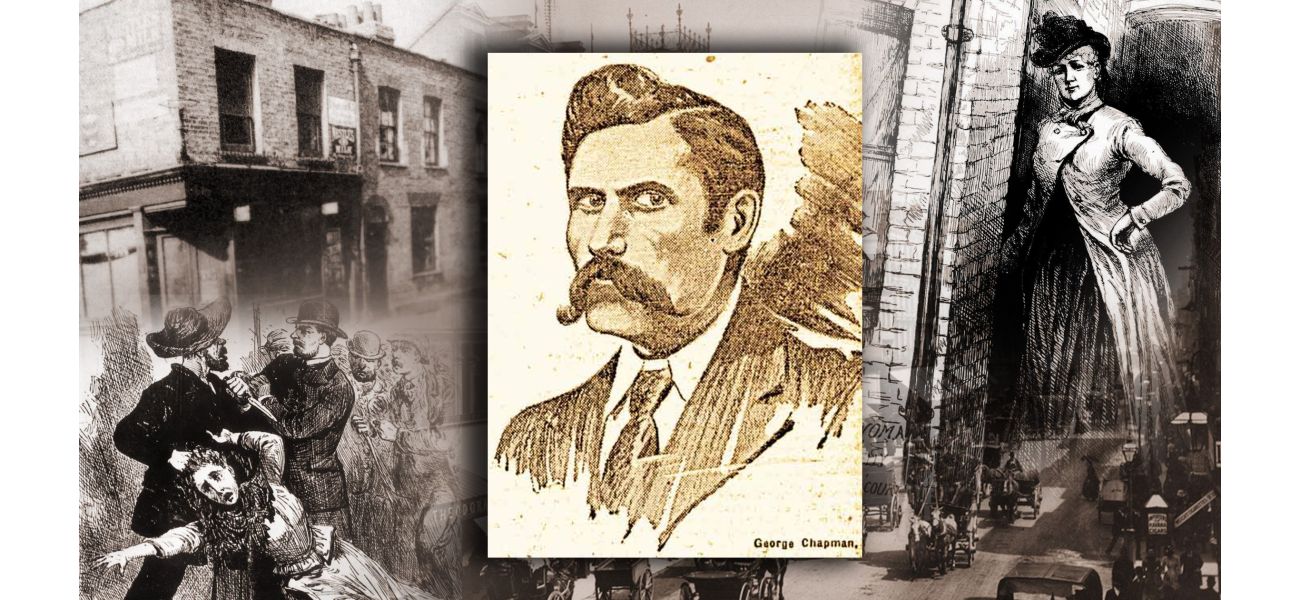A Polish barber with a possible connection to Jack the Ripper.
George Chapman lived in London during the Ripper murders.
October 7th 2024.

George Chapman was a man who lived in the bustling Whitechapel area of London during the notorious Jack the Ripper murders in the late 1800s. It was a time of fear and confusion as the infamous serial killer terrorized the streets, leaving behind a trail of gruesome murders that have remained unsolved to this day.
The Ripper's reign of terror lasted from August to November of 1888, and his primary target was the vulnerable and marginalized group of female sex workers in Whitechapel. At least five women were brutally killed, with all but one of them being horrifically mutilated in the process. The brutal nature of the killings led many to believe that the perpetrator could possibly be a doctor.
One of the detectives working on the case, Dr. Llewellyn, theorized that the killer must have had some knowledge of anatomy, as he specifically targeted vital organs in his victims' bodies. Despite the efforts of the police, who interviewed over 2,000 people and detained 80 suspects, the Ripper was never caught. This has sparked a fascination with the case, and over the years, many theories have emerged about the true identity of Jack the Ripper.
One of the popular suspects is a man named Aaron Kosminski, a paranoid schizophrenic with a known hatred for women. Another is Montague John Druitt, a schoolmaster who was deemed "sexually insane." There are even more obscure theories, such as the idea that Queen Victoria's grandson, Prince Albert Victor, was the killer, or that a woman named Mary Pearcey, who had killed her lover and his family in 1890, could be the Ripper.
However, for Detective FG Abberline, who was tasked with hunting down Jack the Ripper, there was only one name on his mind: George Chapman. In 1903, Abberline shocked the country when he told the press that he believed Chapman to be the elusive killer. But who was this man, and what led the detective to believe he was Jack the Ripper?
George Chapman, born Severin Klosovski in Poland, moved to London in 1888 and worked in a barber shop on Whitechapel High Street. He then spent some time in America before returning to England and adopting the name George Chapman. He worked as a barber in Hastings, East Sussex, before returning to London to continue his trade.
In 1889, Chapman married a woman named Lucie Badewski, whom he had met at a Polish club in Clerkenwell. However, the marriage only lasted three years, as Chapman had a tendency to lose interest in his partners and move on to someone else. Three of his wives, including Lucie, died in suspicious circumstances, with all of them becoming incredibly sick and dying quickly.
Chapman's behavior and the deaths of his wives raised suspicion, and it was discovered that he had been purchasing a poisonous substance called emetic tartar from a chemist in Hastings. This poison was also used by another infamous murderer, the "Teacup Murderer" Graham Young, in Hertfordshire. After his third wife, Maud Marsh, died in 1902, Chapman was arrested and charged with her murder.
During his three-day trial, Chapman was dubbed the "Southwark Poisoner" by the media. It was revealed that he had poisoned all three of his wives, even though he stood to gain nothing from their deaths. He was convicted and sentenced to death by hanging, and on April 7, 1903, he was executed at Wandsworth Prison.
Many have speculated that George Chapman was also Jack the Ripper, and there is some evidence to support this theory. His connection to Whitechapel, his knowledge of anatomy, and his tendency to kill women he was involved with are all similarities to the Ripper's crimes.
However, there is no definitive proof that Chapman was, in fact, Jack the Ripper. The case remains one of the greatest unsolved crime mysteries in British history, and the true identity of the Ripper may never be known. But the story of George Chapman, the man who was convicted of poisoning his wives, will forever be intertwined with that of Jack the Ripper.
George Chapman lived in the Whitechapel area of London during the infamous Jack the Ripper murders of 1888. His presence in the same location where the murders took place has led some to believe that he may have been the notorious serial killer. However, there is no concrete evidence linking Chapman to the murders and he has never been officially named as a suspect by the police.
Jack the Ripper is believed to have killed at least five female sex workers in the Whitechapel area between August and November 1888. The brutal and gruesome nature of the killings, along with the fact that the Ripper seemed to have anatomical knowledge, has sparked theories that the culprit may have been a doctor. Dr. Llewellyn, who investigated one of the Ripper's victims, theorized that the murderer had knowledge of the human body as he had attacked all the vital parts.
Despite intense investigations, including interviewing over 2,000 people and detaining 80 suspects, the police were never able to catch Jack the Ripper. Over the years, numerous theories and suspects have emerged, including Aaron Kosminski, a paranoid schizophrenic with a hatred for women, and Montague John Druitt, a schoolmaster deemed "sexually insane." Some even believe that Queen Victoria's grandson, Prince Albert Victor, or a woman named Mary Pearcey, who killed her lover and his family, could have been the Ripper.
However, for Scotland Yard detective FG Abberline, who was assigned to the case at the time of the murders, there was only one suspect he was convinced was the Ripper - George Chapman. In 1903, Abberline publicly stated that he believed Chapman was the elusive killer, shocking the country.
So, who was George Chapman? Born as Severin Klosovski in Poland in 1865, Chapman moved to London in 1888 to work in a barber shop in Whitechapel. He later spent time in America before returning to England and adopting the name George Chapman. He had a habit of seducing and marrying women, only to lose interest and move on to the next one. Three of his wives - Mary Spink, Bessie Taylor, and Maud Marsh - all died suspiciously, with Chapman being the common denominator in their deaths.
Chapman's method of killing was by using emetic tartar, a poison that he purchased from a chemist in Hastings. This same poison was used by another notorious murderer, Graham Young, known as the "Teacup Murderer." Mary Spink, Bessie Taylor, and Maud Marsh all died after ingesting this poison, with symptoms that included vomiting and diarrhea. Suspicion was raised when Maud's family noticed her becoming increasingly ill without any apparent cause.
The bodies of Bessie and Mary were exhumed and traces of poison were found, leading to Chapman's arrest and subsequent trial. He was convicted and sentenced to death by hanging in 1903, with journalists dubbing him the "Southwark Poisoner." Before his execution, Chapman refused to see his first wife, Lucie, who had requested a visit.
Although George Chapman lived in the same area as the Jack the Ripper murders and had a history of poisoning women, there is no concrete evidence linking him to the infamous crimes. However, his case remains a subject of interest for many, with some speculating that he may have had the potential to commit such heinous acts.
The Ripper's reign of terror lasted from August to November of 1888, and his primary target was the vulnerable and marginalized group of female sex workers in Whitechapel. At least five women were brutally killed, with all but one of them being horrifically mutilated in the process. The brutal nature of the killings led many to believe that the perpetrator could possibly be a doctor.
One of the detectives working on the case, Dr. Llewellyn, theorized that the killer must have had some knowledge of anatomy, as he specifically targeted vital organs in his victims' bodies. Despite the efforts of the police, who interviewed over 2,000 people and detained 80 suspects, the Ripper was never caught. This has sparked a fascination with the case, and over the years, many theories have emerged about the true identity of Jack the Ripper.
One of the popular suspects is a man named Aaron Kosminski, a paranoid schizophrenic with a known hatred for women. Another is Montague John Druitt, a schoolmaster who was deemed "sexually insane." There are even more obscure theories, such as the idea that Queen Victoria's grandson, Prince Albert Victor, was the killer, or that a woman named Mary Pearcey, who had killed her lover and his family in 1890, could be the Ripper.
However, for Detective FG Abberline, who was tasked with hunting down Jack the Ripper, there was only one name on his mind: George Chapman. In 1903, Abberline shocked the country when he told the press that he believed Chapman to be the elusive killer. But who was this man, and what led the detective to believe he was Jack the Ripper?
George Chapman, born Severin Klosovski in Poland, moved to London in 1888 and worked in a barber shop on Whitechapel High Street. He then spent some time in America before returning to England and adopting the name George Chapman. He worked as a barber in Hastings, East Sussex, before returning to London to continue his trade.
In 1889, Chapman married a woman named Lucie Badewski, whom he had met at a Polish club in Clerkenwell. However, the marriage only lasted three years, as Chapman had a tendency to lose interest in his partners and move on to someone else. Three of his wives, including Lucie, died in suspicious circumstances, with all of them becoming incredibly sick and dying quickly.
Chapman's behavior and the deaths of his wives raised suspicion, and it was discovered that he had been purchasing a poisonous substance called emetic tartar from a chemist in Hastings. This poison was also used by another infamous murderer, the "Teacup Murderer" Graham Young, in Hertfordshire. After his third wife, Maud Marsh, died in 1902, Chapman was arrested and charged with her murder.
During his three-day trial, Chapman was dubbed the "Southwark Poisoner" by the media. It was revealed that he had poisoned all three of his wives, even though he stood to gain nothing from their deaths. He was convicted and sentenced to death by hanging, and on April 7, 1903, he was executed at Wandsworth Prison.
Many have speculated that George Chapman was also Jack the Ripper, and there is some evidence to support this theory. His connection to Whitechapel, his knowledge of anatomy, and his tendency to kill women he was involved with are all similarities to the Ripper's crimes.
However, there is no definitive proof that Chapman was, in fact, Jack the Ripper. The case remains one of the greatest unsolved crime mysteries in British history, and the true identity of the Ripper may never be known. But the story of George Chapman, the man who was convicted of poisoning his wives, will forever be intertwined with that of Jack the Ripper.
George Chapman lived in the Whitechapel area of London during the infamous Jack the Ripper murders of 1888. His presence in the same location where the murders took place has led some to believe that he may have been the notorious serial killer. However, there is no concrete evidence linking Chapman to the murders and he has never been officially named as a suspect by the police.
Jack the Ripper is believed to have killed at least five female sex workers in the Whitechapel area between August and November 1888. The brutal and gruesome nature of the killings, along with the fact that the Ripper seemed to have anatomical knowledge, has sparked theories that the culprit may have been a doctor. Dr. Llewellyn, who investigated one of the Ripper's victims, theorized that the murderer had knowledge of the human body as he had attacked all the vital parts.
Despite intense investigations, including interviewing over 2,000 people and detaining 80 suspects, the police were never able to catch Jack the Ripper. Over the years, numerous theories and suspects have emerged, including Aaron Kosminski, a paranoid schizophrenic with a hatred for women, and Montague John Druitt, a schoolmaster deemed "sexually insane." Some even believe that Queen Victoria's grandson, Prince Albert Victor, or a woman named Mary Pearcey, who killed her lover and his family, could have been the Ripper.
However, for Scotland Yard detective FG Abberline, who was assigned to the case at the time of the murders, there was only one suspect he was convinced was the Ripper - George Chapman. In 1903, Abberline publicly stated that he believed Chapman was the elusive killer, shocking the country.
So, who was George Chapman? Born as Severin Klosovski in Poland in 1865, Chapman moved to London in 1888 to work in a barber shop in Whitechapel. He later spent time in America before returning to England and adopting the name George Chapman. He had a habit of seducing and marrying women, only to lose interest and move on to the next one. Three of his wives - Mary Spink, Bessie Taylor, and Maud Marsh - all died suspiciously, with Chapman being the common denominator in their deaths.
Chapman's method of killing was by using emetic tartar, a poison that he purchased from a chemist in Hastings. This same poison was used by another notorious murderer, Graham Young, known as the "Teacup Murderer." Mary Spink, Bessie Taylor, and Maud Marsh all died after ingesting this poison, with symptoms that included vomiting and diarrhea. Suspicion was raised when Maud's family noticed her becoming increasingly ill without any apparent cause.
The bodies of Bessie and Mary were exhumed and traces of poison were found, leading to Chapman's arrest and subsequent trial. He was convicted and sentenced to death by hanging in 1903, with journalists dubbing him the "Southwark Poisoner." Before his execution, Chapman refused to see his first wife, Lucie, who had requested a visit.
Although George Chapman lived in the same area as the Jack the Ripper murders and had a history of poisoning women, there is no concrete evidence linking him to the infamous crimes. However, his case remains a subject of interest for many, with some speculating that he may have had the potential to commit such heinous acts.
[This article has been trending online recently and has been generated with AI. Your feed is customized.]
[Generative AI is experimental.]
0
0
Submit Comment





